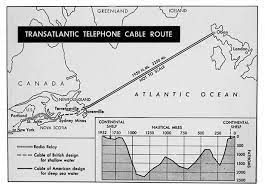On September 25, 1956, a significant technological achievement was realized with the establishment of the first-ever underwater telephone service. This groundbreaking development allowed for communication between submerged vessels and shore stations, opening up new possibilities for underwater exploration, military operations, and scientific research. The underwater telephone service was a collaborative effort between the United States Navy and private telecommunications companies. Its primary purpose was to provide a reliable and efficient means of communication for submarines and other underwater vessels. Prior to this innovation, communication between submerged submarines and surface ships or land-based stations was extremely limited, relying on slow and unreliable methods such as signal flags or flashing lights. The underwater telephone service utilized advanced technology to overcome the challenges of transmitting sound through water. Specialized equipment, including hydrophones and transducers, were developed to convert sound waves into electrical signals that could be transmitted through cables or wireless channels. These signals were then decoded and converted back into sound at the receiving end. The successful implementation of the underwater telephone service had a profound impact on various fields. In the military sector, it revolutionized submarine warfare by enabling real-time communication between submarines and their command centers. This greatly enhanced the effectiveness and coordination of naval operations, allowing for improved strategic planning and tactical decision-making. Furthermore, the underwater telephone service played a crucial role in scientific research and exploration. It facilitated communication between scientists and researchers working on underwater projects, enabling them to exchange information, coordinate experiments, and share discoveries. This advancement opened up new opportunities for studying marine life, exploring underwater ecosystems, and conducting geological surveys. The benefits of the underwater telephone service were not limited to military and scientific applications. It also had significant implications for the commercial sector. The ability to communicate with submerged vessels allowed for more efficient management of underwater construction projects, such as the laying of submarine cables or the construction of offshore oil rigs. It also facilitated the efficient coordination of underwater salvage operations and deep-sea exploration for natural resources. The establishment of the underwater telephone service on September 25, 1956, marked a milestone in telecommunications history. It showcased the power of human ingenuity and technological innovation in overcoming challenges and pushing the boundaries of what was previously thought possible. This achievement laid the foundation for further advancements in underwater communication and set the stage for future developments in underwater technology. Subsequent years saw continued progress in underwater communication systems, with advancements in wireless technology and the development of more sophisticated equipment. These improvements led to the creation of underwater acoustic networks, which allowed for the establishment of underwater internet connections and the transmission of data at higher speeds. The establishment of the underwater telephone service on September 25, 1956, paved the way for a new era of underwater communication and exploration. It revolutionized military operations, scientific research, and commercial endeavors, opening up new possibilities for human interaction with the underwater world. This achievement remains a testament to human curiosity, innovation, and the relentless pursuit of knowledge.
25 Sept, 1956 Underwater Telephone Service
